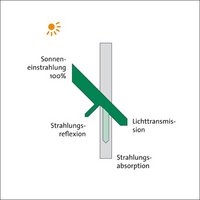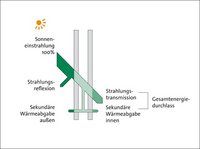Principles of solar control
Light transmittance LT
The light transmittance of a glazing product describes the percentage share of solar radiation in the range of visible light that is let through from the outside to the inside. The LT value depends among others on the coating systems. The Isopane Silverstar Combi coatings in particular have been optimised for selecting solar radiation according to light and heat energy.
b-factor
The b-factor is the quotient of the total energy transmittance of a glazing product and the total energy transmittance of uncoated insulation glass. The b-factor is therefore a measure of solar control. The g-value of uncoated double insulation glass is taken here as the constant with 80%. Isopane Combi Neutral 70/35 for example has a total energy transmittance of 37%.
b-factor = 0.37/0.80 = 0.46
General colour rendering index Ra
The colour rendering index compares colour changes of objects located behind the coated thermal insulation glass. A standard light source is used for the technical test. The scale for Ra extends to 100. The maximum Ra value that glazing can achieve is 99.
Selectivity coefficient S
The selectivity coefficient describes the ratio of light transmittance to total energy transmittance. The S coefficient evaluates solar control glass in terms of a desired high light transmittance in ratio to the also intended low total energy transmittance. A high selectivity coefficient expresses a favourable ratio.
S = light transmittance/total energy transmittance
Colour-matching balustrade panels
Colour-matching balustrade panels are available for every glazing type for harmonious design of all-glass facades. These are suitable for warm and cold facade structures. The colour-matching balustrade panels usually consist of heat-strengthened glass.
Radiation absorption
Radiation absorption or energy absorption refers to the share of radiation in the complete range of the solar spectrum which is absorbed by the glazing.
High radiation absorption
Solar control glass should generally be toughened for glass combinations with radiation absorption that clearly exceeds 50%.
UV transmission
In contrast to conventional insulation glass combinations, Isopane solar control glass has far lower UV transmission values.
Total energy transmittance
The g-value states how much energy from the incoming solar radiation passes through the glazing into the room. It consists of two parts: direct radiation transmission and secondary heat emission. Secondary heat emission results from the fact that the glass heats up due to solar radiation so that the glass itself then emits heat to the inside and outside.



